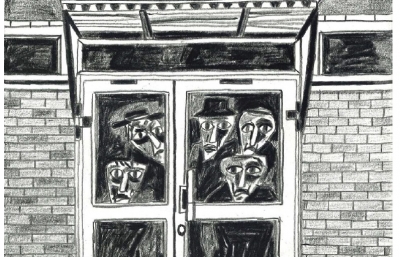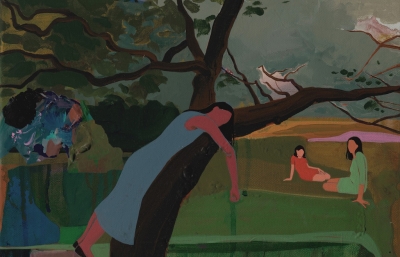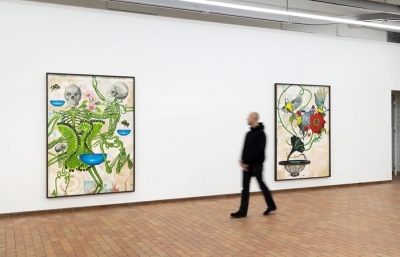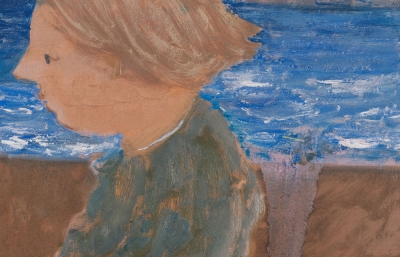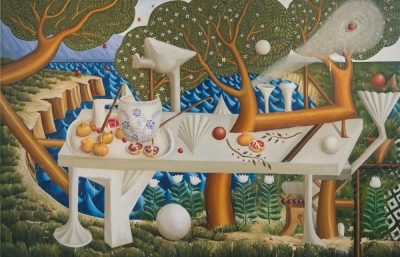Layla Andrews
Luminary Light
Interview by Kristin Farr // Portrait by Jacob Hill
Layla Andrews is currently brightening Brixton and beyond with dynamic portraits of humankind and anthropomorphized creatures, like her signature crocodile. She’s currently working on secret new projects after successful exhibitions and chance discoveries of her work by iconic luminaries.
Raised to be resourceful in a matriarchal household, her work does not speak to exclusivity, but to a populist audience. Andrews summons the depth of her own experience, while also practicing storytelling that is wide open for interpretation and welcomes accessibility for all viewers. Andrews is of many fields—art, activism, history—a writer, and an unmatched, singular soul. Her talent and ability to represent inspirational figures jump-started her rise to fame as a teenager, just a handful of years ago, and we see the National Portrait Gallery in her future.

Kristin Farr: Early on, there were two prominent acknowledgements of your portraits. Nelson Mandela’s foundation acquired your painting of him, and then you caught the attention of Barack Obama when a family friend working at the White House displayed your portrait of the President. Did those opportunities lead to new developments over the last few years?
Layla Andrews: Yes, I believe so. I think people, myself included, were quite amazed when Obama reached out to me about my work, and were therefore quite intrigued by my practice. It was extremely bolstering having a person I admire reach out so early on in my career; it somewhat laid a platform of confidence for me moving forward.
Tell me about your relationship or responses to color, and what kinds of everyday color moments inspire your work.
Color has always played an integral role within my work. Strangely enough, when I first started painting, I naturally found that painting with colors that were not in the image far easier than working precisely with what was in front of me. I am not entirely sure how to describe the process, but I often see colors out and about and I can immediately visualize where they should go within a piece or what they should sit next to.
What are your most revisited color combinations?
Hmm… reds, olive greens, blacks, whites, peach-pink and mustard are often my go-to combinations.
Is it important for your artwork to feel loud?
I think more than loud, it is important for me that art reaches people. As time has gone by, I have found that the most important element for me, within my work, is that people can connect or interact with it in some human capacity. I believe that storytelling is thematic within my work. Art isn’t here to serve a select few, it should be inclusive and encourage people from all backgrounds to feel something from it.

Do your dreams affect your paintings?
I think so. I am an incredibly visual thinker and I do struggle with intense dreaming; sometimes it’s fascinating, sometimes quite visceral and intense. I think the way I interpret shape and colour during the day do crop up in both my work and in my sleep.
Let’s talk about crocs! The crocodile has been a very communicative character in your recent paintings.
I have always loved crocs and have been painting them since the start of my career. I feel there is a real sweetness to them. It probably stems from when I was a child; I had a book which depicted a mother crocodile teaching her baby how to eat spaghetti. I loved it. In more recent times, trips to Cuba, Florida and Mexico have definitely contributed to my love for them.
How about shellfish? What do they symbolize for you?
I love the sea, and think shellfish and crustaceans harbor both a great wisdom and aesthetically look fabulous. Scientists believe that lobster-like creatures have been around roughly 360 million years, transcending human existence, which makes sense to me.
Tell me about your early sculptural work, and do you still make sculptures these days?
I love making sculptural pieces. It is really mindful not thinking too much and just using your hands to create. Costume and fashion have always played a significant role in my interests ever since I was a child. Years ago, I began making large, sculptural heads that could be worn. I plan to continue working with materials to create exciting and odd things.

Can you tell me about the island of St. Helena and your show inspired by it, Saints?
The Saints collection is inspired by a volcanic, tropical island’s modification of country and western music and culture. Situated in the South Atlantic Ocean, measuring roughly ten by five miles, St. Helena, until very recently, had been one of the most challenging and remote places to access in the world; it is where my Grandad is from. He has the most amazing stories from his time there, and one day asked if I would like to capture them. Frank and Gordy at Jamestown Jail, for example, is based on his job as a prison warden. As you can imagine, the jail is tiny, with only a few people in there. My grandad was appointed to watch a chap named Gordy—it turned out to be a friend of his from when they were children. They still got on so well and would play cards and music together. I think that dynamic is so fascinating; I knew I had to capture it.
What was the area of concentration in your history degree studies?
I studied history at university. It was an amazing interdisciplinary course that combined politics, philosophy and cultural studies. My area of study primarily focused on the politics of race and colonialism within the twentieth century, how it was depicted and used in relation to power, and how that is so relevant today. I won the history prize—show off! Studying history at university is an incredibly enriching experience. It’s a real shame that these fundamental topics are not taught more in schools; society would be a better place if that was the case.
Are there historic or social justice references in your recent work?
Years ago, a lot of my work was centered explicitly on socially important subjects close to my heart. I worked with conservation organizations that help tackle human and wildlife conflict and climate change, as well as amazing charities such as Pride London and Choose Love. More recently, I feel my work has moved slightly away from being as overt. I still create work to support and raise money for charities I admire, but the painting content is primarily more personal. Accessibility and making the art world less elusive and more fair is my current priority.
Is it true you paint with your hands?
I used to far more. I find it easier to mix colours and work the paint into a piece by hand. I also love how the paint sits on board or canvas when hand-blended. I still paint with my hands in sections but brushes feature also.

You’ve inspired empathy worldwide for your recent written work about grief among non-nuclear families. You also used the word cathartic to describe your practice. Does painting help you work through grief in some ways?
I work and create art best when I am feeling positive, so, therefore, found trying to create work initially very challenging. Writing helped a lot; I was able to express and make sense of my thoughts, as well as clear space in my mind for creating art. Grief is a big knock to your identity, and I do feel as though my career as an artist has helped soften that particular blow a little. I think the act of making something, be it a chair, a cake or a painting, is ultimately positive—that’s what I have found anyway. To have an idea and see it come alive as a physical thing that you have created never gets old for me. I feel very grateful to be able to do what I do.
You’ve noted the importance of secondhand shopping for your own creative expression, and how the gentrification of thrift shops can block opportunities for young artists. Can you talk more about how re-use inspired you as an artist growing up?
I come from a very resourceful family. My mum and my nan encouraged my sister and me to gather and source materials and things we needed to experiment artistically from secondhand shops and carboot sales. I think it has been a fundamental element of my identity as an artist; it helped form my style and love for art, antiques, costumes and props. Secondhand shopping made accessing the art world possible for me. I was able to experiment with tools and materials that are not always accessible for working class children. Thank goodness for carboots!
Tell me about a project you made as a kid.
As a child, I went through a roughly three-year pirate obsession. I took set design, costume and props way too seriously, and, in turn, ensured my entire bedroom felt like an authentic pirate’s den: treasure, maps, empty rustic rum bottles, mystical antique sea props, etc., all sourced from secondhand stores. I wanted an old barrel to replace my chair—my mum drew the line there, as most of the ones I came across were a little moldy. She was very patient during the pirate phase!
What was your best vintage fashion score?
Now that is a hard question. I bought a pair of red leather cowboy boots from a carboot in Brighton for three pounds many years ago. I wear them most days. My favorite tiger-print velvet coat was four euros from an antique market in Amsterdam—it remains my most fabulous coat, and I hope I am still rocking it as an old lady.
LaylaAndrews.com
@laylandrews


